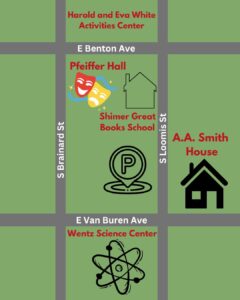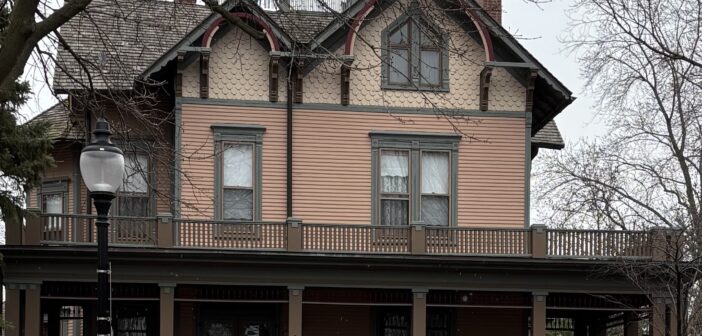Early history
Augustine Austin Smith (A.A. Smith), was the first president of NCC from 1861-1883. In the beginning, the college was located in Plainfield, Illinois. Smith administered the move to Naperville onto the land that is now NCC. He also oversaw the construction of Old Main, the first college building on campus.
President Smith purchased the land where the house is now located in 1872. However it was his son, Professor Henry C. Smith and daughter-in-law who set up construction for the house. The house became a part of Naperville’s historic district with its classic Victorian style.

Graphic created by Sasha Baumgartner via Canva.
“In 1872, two blocks from the majestic Old Main building, A.A. Smith purchased a corner
lot. In 1885, his son and daughter-in-law, Henry C. and Mary Smith, built a classic Victorian
house in the Eastlake style,” Bartley Madden said.
Madden and his wife restored the home after purchasing it in 1999. They later donated the property to NCC in 2008 after the restoration was complete.
Tragedy occurs
Although the A.A. Smith House has deep historic roots, that is not what it is famous for. The home is recognized by many because of a devastating event that occurred in the home in 1999.
On March 4, 1999 Marilyn Lemak, the homeowner at the time, murdered her three children ages seven, six and three in the home .
Ray McGury, who was the Naperville park district executive director at the time of the case, can still recall how difficult this murder was for the law enforcement working on it. He recalled the case in an interview done 20 years later by Suzanne Baker for the Chicago Tribune.
“[The Lemak case is] pretty gut-wrenching that cuts to your core. I am still trying to make sense of how a mother, and the bond mothers have with their children, can kill these small children.”
Lemak struggled with depression for years. She had first filed for divorce from her husband and father of the children in 1997. She changed her mind and stopped pursuing divorce that year. The following year, she filed again. Lemak was struggling with her husbands new relationship with another woman. That is what is said to have pushed her to spiral in 1999.
“A 2012 interview with French television channel m6 – her first and only public comments since her arrest made national headlines – Lemak said a deepening depression amid a bitter divorce prompted her to drug and suffocate her children,” wrote Baker.
Lemak was found guilty on all charges and sentenced to life in prison. She is currently serving at the Logan Correctional Center in Lincoln, Illinois.
New homeowners
In 1999, after the tragedy occurred, a couple was searching for a historic home to raise their family. Bartley and Maricela Madden purchased the A.A. Smith house with the hopes of refurbishing and restoring the home to its original historical roots.
“It was hideous on the outside when we first moved in. I knew nothing of the Victorian period. I educated myself and did research,” Maricela Madden, ’99, said.
Built in 1872, according to records the house had undergone many renovations and changes over the years. Maricela was able to find original photos of the house from when Smith lived in it which helped her on her restoration journey.
“The arch on the top of the house was missing. I came across a book of his house in Naperville and it showed the arch,” Madden said.
Restoration
The Madden’s added the arch back onto the house. The siding was in bad shape from wear and tear over the years, therefore the family had someone come restore and repaint the house. Additionally the family redid the porch and stabilized it.
As far as the interior of the A.A. Smith House, every room needed work.
“Restored the wood, window trim, door trim and radiators. Removed all windows, all doors were stripped and refinished. Replaced all trim, some rooms did not even have crown molding,” Madden said.
The family gutted the entire kitchen besides the Butler’s pantry. They started by removing the cabinets and then brought in new cabinets to match the ones in the Butler’s pantry. They replaced all the kitchen appliances, but they made the new appliances look antique. Patented tiles were brought in to cover the surface of the kitchen island. Another major change was taking down one of the staircases in the home. There was a staircase in the back of the house from the Butler’s Pantry up to the second floor. Maricela removed the staircase and placed a big bay window instead.
Unfortunately, the original hardwood flooring in the house was not salvageable. A new oak floor with inlay was put in throughout the entire house.
“[There were] 9 phases of reconstruction. Started with the bedrooms and the second floor first,” Madden said.
The restoration was a long, tedious process. However, the the house now sits as a historical landmark on NCC’s campus, reminding current students and faculty of the historical roots of the College. The house is used by the college to host meetings and events frequently.

